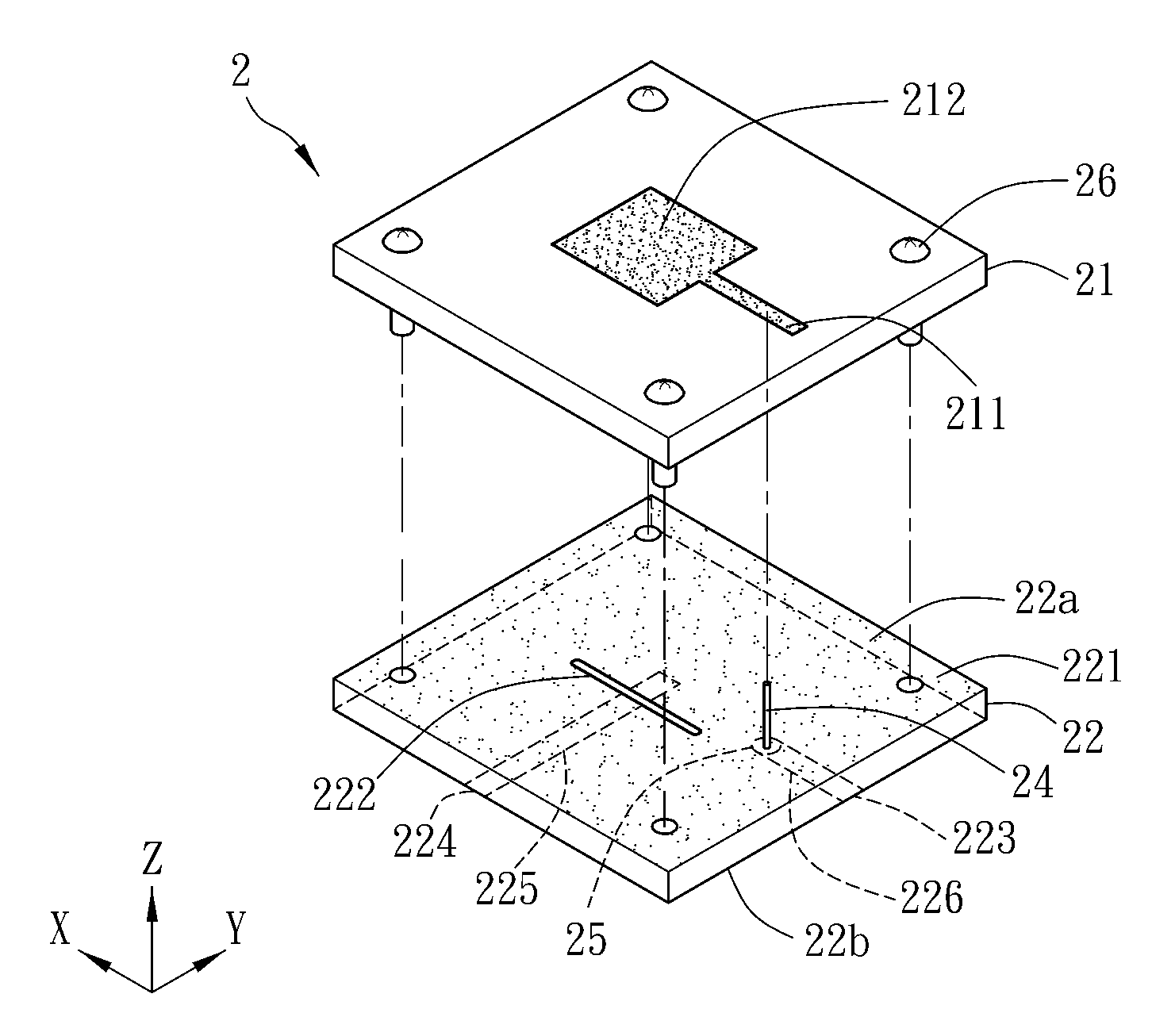Dual-polarized dual-feeding planar antenna
a planar antenna and dual-polarized technology, applied in the direction of antennas, resonant antennas, radiating element structural forms, etc., can solve the problem of limiting the application of antennas, and achieve the effects of reducing electromagnetic interference, enhancing isolation between two feeding ports, and increasing isolation
- Summary
- Abstract
- Description
- Claims
- Application Information
AI Technical Summary
Benefits of technology
Problems solved by technology
Method used
Image
Examples
first embodiment
[0036]FIG. 3A is a schematic diagram showing a dual-polarized dual-feeding planar antenna 2 according to the present invention, and FIG. 3B is an exploded view of the dual-polarized dual-feeding planar antenna 2. Referring to FIGS. 3A and 3B, the dual-polarized dual-feeding planar antenna 2 includes a first substrate 21, a second substrate 22 and an air layer 23.
[0037]The first substrate 21 includes a first microstrip 211 and a patch 212 electrically connected with each other. The shape of the patch 212 can be circular, elliptic, or rectangular. In this embodiment, the first substrate 21 is a printed circuit board and includes only one patch 212, and the patch 212 is, for example, a rectangular patch, which is formed on the surface of the first substrate 21 by the circuit printing process. In addition, the first microstrip 211 and the patch 212 can be located on the same surface or different surfaces of the first substrate 21. In this embodiment, the first microstrip 211 and the pat...
second embodiment
[0043]FIG. 4 is an exploded view of a dual-polarized dual-feeding planar antenna 2a according to the present invention. Referring to FIG. 4, the dual-polarized dual-feeding planar antenna 2a further includes a phase shift circuit 27, which is electrically connected with the first and second feeding ports 223 and 224. In this embodiment, the phase shift circuit 27 is, for example, a branch line coupler, and the feeding port 27b of the phase shift circuit 27 usually connects to a 50Ω load. Since the electrical length of each of the sections 271 and 272 of the coupler is about a quarter of the wavelength of the operation bandwidth, the phase difference between the first and second feeding ports 223 and 224 is 90 degrees as the energy is fed into the feeding port 27a. This can obtain a circular polarization antenna, which is capable of achieving right or left circular polarization.
third embodiment
[0044]FIG. 5A is a schematic diagram showing a dual-polarized dual-feeding planar antenna 3 according to the present invention, and FIG. 5B is an exploded view thereof. The antenna array composed of a plurality of patches is provided to reach the desired gain.
[0045]In this embodiment, the dual-polarized dual-feeding planar antenna 3 is a 2×2 array for example. Besides, the first substrate 31 of the dual-polarized dual-feeding planar antenna 3 further includes an impedance converter 318, which is electrically connected to the first microstrip 311. In addition, the second substrate 32 also includes an impedance converter 328, which is electrically connected to the second microstrip 325. Herein, the impedance converters 318 and 328 are used for impedance matching. The impedance converter 318 is a taper quarter-wavelength impedance converter, which can reduce the discontinuous effect during impedance converting.
[0046]In this embodiment, the planar antenna 3 also includes, for example, f...
PUM
 Login to View More
Login to View More Abstract
Description
Claims
Application Information
 Login to View More
Login to View More - R&D
- Intellectual Property
- Life Sciences
- Materials
- Tech Scout
- Unparalleled Data Quality
- Higher Quality Content
- 60% Fewer Hallucinations
Browse by: Latest US Patents, China's latest patents, Technical Efficacy Thesaurus, Application Domain, Technology Topic, Popular Technical Reports.
© 2025 PatSnap. All rights reserved.Legal|Privacy policy|Modern Slavery Act Transparency Statement|Sitemap|About US| Contact US: help@patsnap.com



